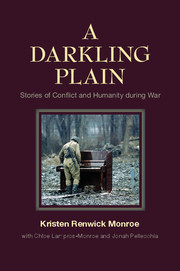Book contents
- Frontmatter
- Epigraph
- Contents
- Preface
- Introduction
- Part one War is a Terrible Thing!
- Part Two Guarding One’s Humanity During War: World War II
- 2 If Something’s Going to Get You, It’ll Get You
- 3 Prejudice, Bigotry, and Hatred. Love and Luck
- 4 Everything Went Downhill after that
- 5 In the Middle of a Hailstorm, One doesn’t Fear for One’s Own Life
- 6 Belonging to Something
- 7 Hard to Adjust After all that
- Part Three Other Voices, Other Wars: From Indochina to Iraq
- Part Four Civil Wars and Genocides, Dictators and Domestic Oppressors
- Part Five My Story, Your Choice How to Use it
- Conclusion
- Bibliography
- Acknowledgments by the Senior Author
- Index
5 - In the Middle of a Hailstorm, One doesn’t Fear for One’s Own Life
The Red Princess and the July 20th Plot to Kill Hitler
Published online by Cambridge University Press: 05 October 2014
- Frontmatter
- Epigraph
- Contents
- Preface
- Introduction
- Part one War is a Terrible Thing!
- Part Two Guarding One’s Humanity During War: World War II
- 2 If Something’s Going to Get You, It’ll Get You
- 3 Prejudice, Bigotry, and Hatred. Love and Luck
- 4 Everything Went Downhill after that
- 5 In the Middle of a Hailstorm, One doesn’t Fear for One’s Own Life
- 6 Belonging to Something
- 7 Hard to Adjust After all that
- Part Three Other Voices, Other Wars: From Indochina to Iraq
- Part Four Civil Wars and Genocides, Dictators and Domestic Oppressors
- Part Five My Story, Your Choice How to Use it
- Conclusion
- Bibliography
- Acknowledgments by the Senior Author
- Index
Summary
Born January 31, 1912, the Infanta Dona Maria Adelaide of Braganza was the last surviving granddaughter of a Portuguese monarch. Known as the “Red Princess” because of her socialist beliefs, the woman code-named Mafalda by the resistance studied in Vienna during World War II, traveling at night to help war victims, including Jews in hiding. She worked with the von Stauffenberg group and was arrested and tortured after the group failed to assassinate Hitler in July 1944. The Nazis condemned Mafalda to death but Salazar – fascist ruler of Portugal – is believed to have intervened with the Germans, possibly because of her royal status. This intervention resulted in her release and immediate deportation. In 1945, Mafalda married Nicolaas van Uden, a Dutch physician, with whom she worked as a nurse and social assistant caring for children in Vienna, Africa, and Portugal.
For more than 50 years, Mafalda never spoke of her wartime actions. Her grandson learned of them when he was assigned The Hand of Compassion in a class in Vienna. In one chapter, Otto Springer describes his resistance work and mentions Mafalda, whom Otto suspected carried secret messages from Churchill to von Stauffenberg agreeing to conditions for German surrender if Hitler were assassinated. Otto described trying to track down Mafalda but noted that he had failed. When Mafalda's grandson read the chapter on Otto he called his father, saying, “I think this is Grandma.” His father used the internet to contact me, received what information I had, and quizzed his mother, who finally owned up to her role in the resistance movement. Eventually, my son Nicholas interviewed Mafalda in Lisbon in October of 2010, with her family in attendance, learning for the first time about some of their mother's activities. Questioners are Nicholas (N), Mafalda's son, and Mafalda's daughter. Mafalda died not long after this interview, on February 24, 2012. After her death, I learned she had a sister named Dona Mafalda, who died in 1918. I do not know if the code name was chosen by Maria Adelaide to honor her sister or whether the similarity was chance.
Information
- Type
- Chapter
- Information
- A Darkling PlainStories of Conflict and Humanity during War, pp. 96 - 102Publisher: Cambridge University PressPrint publication year: 2014
